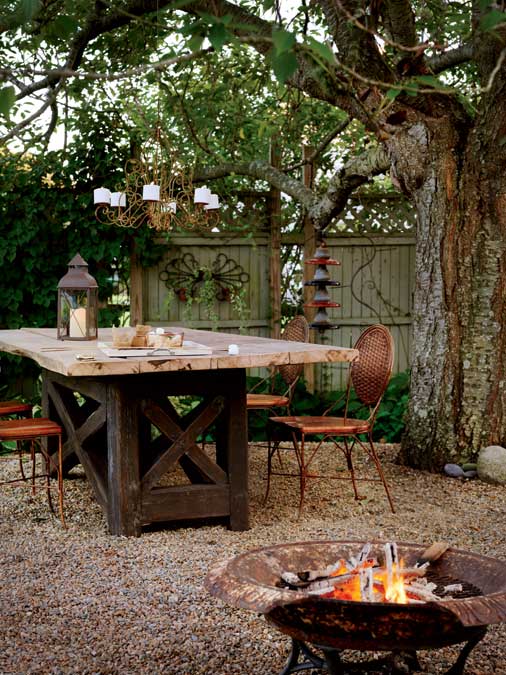An enormous “O” hangs in Jeff Soderbergh’s backyard, dangling from a cherry tree like a giant earring. He eases inside the hand-forged wagon wheel, fitting himself to its iron contours. Who could have guessed, back in the early 1800s when it was first wrought in Pennsylvania, that this utilitarian hoop would achieve a life of leisure in the 21st century?
He balances on the four-inch-wide strip, like Da Vinci’s Vitruvian Man in repose. “My boys sleep in it,” he grins. “Give it a try.”
It’s surprisingly comfortable, and from here I have a good view of “the bubble,” as Jeff calls the lush, half-acre postage stamp in Middletown, Rhode Island, that he shares with his wife, Natasha, and their two little boys, Griffin and Avery. The 980-square-foot house and accompanying workshop are enveloped in thick walls of privet, forsythia, and cypress trees that cushion them from the outside world. And although you can’t see the ocean, which is only about a mile away, you can sense it in the air and light.
For the past few hours we’ve been reminiscing about salvage and how it can be used outside as well as inside your home. Scattered around Jeff’s property are rugged survivors of the past that are ideally suited to backyard use: iron grates, columns, piles of brick, the flotsam and jetsam of salvage warehouses reworked into tables, benches, and yard decorations. And this crazy tree ring that dangles halfway between art and artifact.
The buzzy, of-the-moment expression is “repurposing.” Actually, it’s an adventure in seeing with new eyes. Because once you open them, and take a good look around Jeff’s backyard, you’ll start generating ideas of your own.
“It’s not just old junk,” says Jeff, whose arresting tables and one-of-a-kind beds have been featured in
Architectural Digest, Elle Decor, and
House Beautiful. No wonder—he’s found fresh, elegant uses for massive Gothic windows from Ireland (a bed’s headboard) and wooden rafters and beams from the old Vanderbilt stables in Portsmouth, Rhode Island (a kitchen table with a polished chrome base). His furniture and sculptures incorporate elements as diverse as rare, old-growth chestnut floorboards, copper roof panels, and reclaimed vintage-piano pieces. “The materials meant something to the people who made them,” he says. “That speaks to something in me. It’s our duty to uncover them and give them a second chance.” His efforts are catching on—most recently he’s opened a seasonal showroom in Wellfleet, Massachusetts.
Jeff’s chance at repurposing his own life came more than two decades ago. “I didn’t grow up with salvage,” he emphasizes. “I was a rock-and-roll musician. This all started in 1990 as a total lark. I was walking in Boston one day, and there was a beautiful old brick building coming down. It was such a shame to see cranes ripping apart these gorgeous, arch-topped windows, and the wrecking ball going through this building. It could have been renovated, but instead something new and modern was going there. So I talked to the foreman and said, ‘Can I have a couple of those windows?’ and he said, ‘Take as many as you want.’”
Jeff did, filling up his old Saab hatchback. “I made a mirror for my girlfriend at the time,” he recalls. “She loved it. Her parents loved it and ordered one, and their neighbors ordered one, and my company was born. Eventually the band dissolved and this became a full-time studio in 1999.”
Equally encouraging for the aspiring DIY backyarder: Jeff’s lack of early carpentry skills. “I had zero woodworking background,” he laughs. “I learned everything from books and watching a few mentors. Years ago I would hire a woodworker and say, ‘I really want to make this thing. Can you cut out square holes? I don’t know how to cut out square holes.’ So I’d hire him to do it and I’d watch.”
Now he’s someone people call for advice. For the novice salvage enthusiast, he first advises choosing materials wisely, especially woods for outdoor use. “White oak is really good for outside,” he says. “Cypress is fantastic, and also redwood, which we don’t really have locally. Cedar has a very high natural resistance to rot and decay, which is why cedar fencing is so sought after. But they all need to drain; you can’t just put them on the ground or grass.”
His other advice: Let the object be your guide. Even if you’re not sure what the end product will be, if you’re drawn to something, jump in. “Most of the time I have no idea what I’m going to do with it,” he acknowledges, “but I know I have to have it because there’s just something pleasing about the shape. Obviously I have things in mind, like tables and useful furnishings. But more often than not, I just can’t pass up the texture of that piece of wood or the curve of the metal.” He smiles ruefully: “When I go into a salvage place, I have to leave my wallet out in the car.”
We’re standing in Jeff’s outdoor “living room,” an area in the backyard where weathered Adirondack chairs cozy up to an ancient woodstove donated by a friend. Two concrete industrial sinks, rescued from a scrapyard, spill over with heather and sedum. “I took a grinding wheel to mark them up, and acid-bathed them,” which is why the concrete resembles soapstone, he explains. The slate coffee table was fashioned from kitchen leftovers (“we try to use every piece”); a small vintage grate, welded to a broken chimenea base, has been resurrected as a side table.
Over by the picnic table, a string of yard-art pieces hangs from a tree limb. “They’re ceramic insulators from the ’30s, hand-thrown, so each one is different,” he marvels. “Aren’t they gorgeous?” A weathered chandelier dangles nearby. It used to hang over one of Jeff’s handcrafted tables. “It was a massive steel fire door with an oak-beam trestle base,” he recalls fondly. “I built it for us. We had a client over for dinner, my wife went inside for a moment, and the woman slid her credit card across the table. I said, ‘Dinner’s on us!’ and she said, ‘No, silly, I want the table. Put anything you want on that card.’” He grins: “And like a fool, I didn’t pay off the house!”
“What are you going to do with that?” I point to a small Gothic arch propped in the driveway, as we swerve toward the workshop, a “repurposed” barn from the days when this was a 15-acre orchard filled with apple, walnut, cherry, and peach trees. “Probably just stare at it for a while,” Jeff nods.
We pass other fragments of history waiting for new life. A thick slab of keel from the
Coronet, an 1885 schooner. Pieces of a cypress pickle tank from Massachusetts. Here are stones that were ships’ ballast in merchant vessels coming from England, and cast-iron corbels off a hospital in Taunton. Inside the workshop, he’s got chunks of the old Coney Island boardwalk, which was torn up and replaced with something newer. “I managed to get my hands on 70,000 feet of it,” he says with awe. “An iconic American landmark. How many people walked across it, how many ice-cream cones were dropped on it, how many marriage proposals were made there?”
Later, we visit a Zen garden in a nearby town, where Jeff shows me a bench made from that historic old promenade. Once silvery and splintered, the wood is now rubbed and polished, infused with the memory of long-ago lives. It begs you to sit.
“What I love most is when someone doesn’t even talk to me and they just rub one of my pieces, they just can’t take their hands off it,” he says. “It’s beyond incredible that people respond the way they do. To be able to do this, it’s such a blessing. That I get to leave behind something tangible for people to enjoy and for their kids to enjoy …That what I’m dedicating my life to is hopefully going to make people happy for generations to come.”
To see more of Jeff’s work, go to
jeffsoderbergh.com or visit his seasonal showroom at 11 West Main St. (lower gallery), Wellfleet, MA; 401-845-9087 (studio phone). Open daily Memorial Day weekend through the fall.








